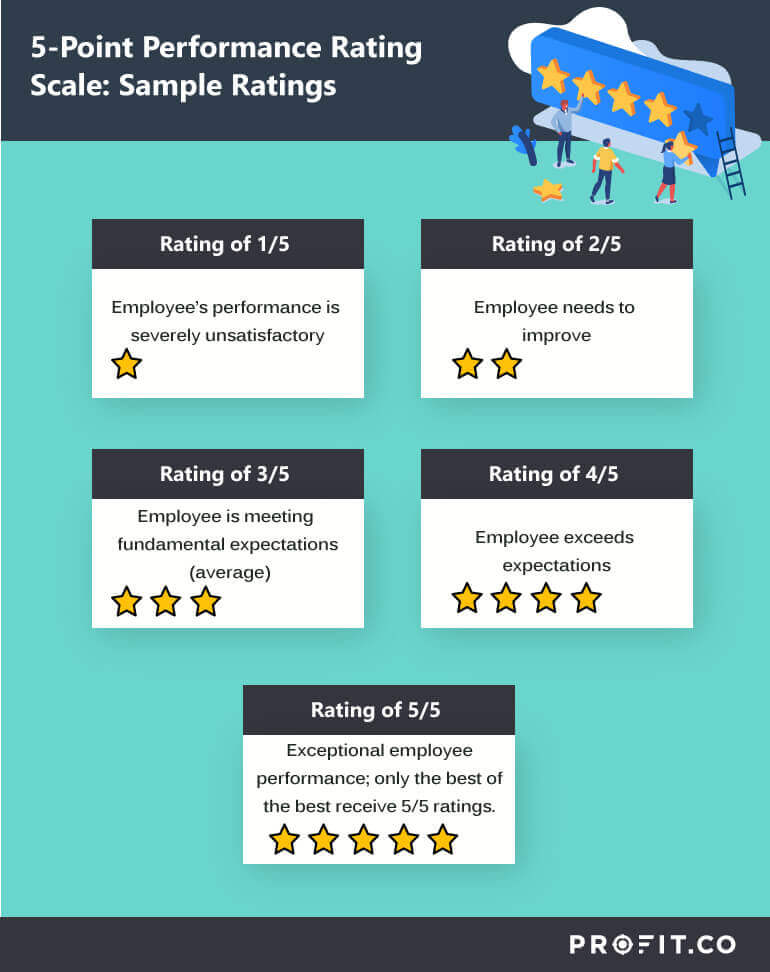The backbone of every organization is the employees who work in it. They are like the intricate gears of a clock; when they stop working, the clock stops ticking.
So, it’s absolutely essential to make sure employees are performing well so that the clock keeps ticking– and the business keeps running smoothly.
But how do we know which employees are up to speed, and which are falling behind?
To sort out the stars as well as the employees who need improvement, HR and managers conduct performance reviews.
Performance reviews walk a fine line between qualitative and quantitative. It can be difficult to try to give helpful, detailed feedback while also measuring an employee’s performance.
This is why rating scales have become a staple of performance reviews in medium and large companies around the world. Rating scales allow for informative evaluations that can still be quantified and compared to help identify employees who are going above and beyond, as well as those who need more guidance.
Why Are Performance Review Rating Scales Useful?
Employee performance rating scales aim to rate all those employed within a firm with the help of a fixed metric. This metric varies depending on the organization’s structure and goals but boils down to it being a simple comparison between dedication levels amongst workers. Such comparisons, in the form of performance review ratings, are extremely useful for a number of reasons.
Firstly, they help employers understand stand-out performers in their organization. Knowing this can help employers select the right people to bestow corporate rewards, bringing us to the second point.
In addition to allowing employees to reward the right person, they will also find it easier to know which employee to select for an important promotion when the time comes. For example, when an older employee retires from a senior post, the only sensible way to go about things is to replace them with a suitable candidate. But how are employers supposed to know who to pick? That’s when employee performance rating scales come into play.
By analyzing a worker’s overall rating score, an employer can get a solid understanding of said worker’s dedication and accurately judge whether they deserve the promotion.
There are also many other benefits of maintaining a record of employee performance review ratings, including using ratings to determine a worker’s raise, whether they should get extended vacation leave, and during compensation planning.
The distance between number one and number two is always a constant. If you want to improve the organization, you have to improve yourself and the organization gets pulled up with you.
What are the Top 3 Rating Scales for Employee Performance?
The HR world is overflowing with many rating scale methods, but not all of these are useful. Some of them may be less efficient than others and using ill-suited ones can ultimately lead the organization away from positive growth.
To help clear the confusion, we have created a list of the top 3 performance review rating scales that are commonly used in offices:
1. The 5-Point Performance Rating Scale
This is, by far, the most commonly used performance review rating scale in the world. The 5-point, or 5-level, rating scale is relatively straightforward. You get to rate the employee out of 5. Each rating level out of 5 has its own unique definition. Here is an explanation of how these values work:

Typically, the reviewers will draft a set of questions to analyze employee behavior. Their questions may be aimed at individual performance, teamwork abilities, timely work submission, or employee output. There is no preset formula for these questions, as every workplace is unique, but some common explains are listed below:
- How often does the employee meet deadlines?
- Does the employee work efficiently in teams?
- Does the employee have a sound understanding of their position in the company?
- Is the employee eager to come up with creative solutions?
- Can the employee efficiently coach interns and new employees?
- Is the employee enthusiastic in the workplace?
- Rate the employee’s work ethic out of 5.
There are, however, certain drawbacks accompanying the 5-point scale system. These are listed below:
- Definition bias:
The 5-point scale heavily depends upon an individual’s understanding of what each number means. Additionally, what “satisfactory” means to one person may not be the same for another. This can cause some conflict during ratings. Some HR professionals give their employees a four instead of a five because their standards for perfection are too high, or some HR professionals rate their employees at 3 for doing the bare minimum.
- Leniency bias:
Some raters do not want to bring down their employees’ hopes, so they may end up giving everyone a higher grade, like a 4 or 5.
- Number bias:
Unless a key or standard reference metric is provided, every rater will have a different understanding of what each rating number means. This is a prevalent example that happens all the time during employee analysis studies.
Sometimes, at the end of the answer sheet, the rater will take out a total of the points given and calculate their average value. This will be the employee’s ultimate score.
2. Likert Scale
The Likert scale is another common example of a rating scale. This type of scale typically has five options, too, but these options are written out rather than numeric.
Here is a sample of the options presented in the Likert scale:
Strongly Disagree – Disagree – Neither Agree nor Disagree – Agree – Strongly Agree
This type of scale is seen in many places, including the MBTI Personality Type Test.
A well-designed Likert scale will uphold the value of symmetry. It will have an equal amount of negative and positive options, along with a neutral option for people to choose if they feel it is appropriate.
Most scales of this type have only five options. However, it is okay to have up to seven, or even as few as three. However, having only three options, including a neutral one, is sometimes too little. On the other hand, allowing seven options can sometimes complicate things. Regardless, it is a smart scaling option that is widely appreciated in offices around the globe.
The Likert scale has been met with some criticism of its own, though. This scale offers a neutral option, suggesting that the reviewer has no opinion on the question matter at hand. This is dangerous because it can be used by reviewers who are slacking off at their own job as a means to fill in the review form without actually contributing anything significant to it.
Another potential downside of the Likert scale is that there is no straightforward method through which employees can be given a score. Unless the 5-point method is fused with the Likert scale, generating an answer average would not be feasible.
3. 10-Point Rating Scale
This option is somewhat similar to the 5-point system. However, it has more options and resembles the action of a school test. 10-point scales are less common than the other two options stated above, but they are still used in many offices.
A 10-point scale has certain benefits that other scales do not offer. For example, this performance review method has a broader set of options to choose from than the Likert scale and 5-point method.
Due to the more extensive options, many people believe that the 10-point scale offers a much clearer image of employee performance. Many critics argue that the 5-point scale is too limited to account for the “in-betweens,” or people who are better than three but not as good as 4, for example.
With a 10-point option, though, this becomes less of a problem.
How to Choose a Suitable Rating Scale
Every HR department should utilize a rating scale to measure employee performance. Here are some pointers that can help you decide which scale to opt for:
- How detailed do you want your answers to be? If you want brief, to-the-point ratings, opt for the 5-point performance rating scale. It is exceptionally straightforward and may be easier to complete. The Likert scale is also a good option as long as it has five or fewer options.
- How fast do you want the review process to be? If you want it to be quick, the 5-point scale is a great option due to its simplistic approach to the questions. The Likert scale with only three options can also be a good choice but remember that these two scales may compromise accuracy.
- How accurate do you want your answers to be? If you want specific answers, opt for the 10-point scale. Or, the Likert scale with 5 or 7 options can also make for an excellent tool.
If none of these tips seem to work for you or you feel like these preset scales aren’t accurate enough to address what your company needs, you can even create your own scale.
How to Create a Rating Scale for Your Organization
Below are some tips to help you come up with a performance review rating scale for your organization:
- Come up with a set of questions. These questions will be answered by the reviewer and should revolve around the employee’s performance and dedication to the job or organization. Your questions should be sensible, too, and must be answerable using your chosen scaling method.
- When creating questions, keep in mind what the end goal is. For example, are you looking for a current staff member to replace a retiring leader? If so, your questions should be based on leadership and should seek to analyze the other employees’ leadership abilities, sense of duty, and other relevant topics.
- Choose a rating scale that feels appropriate. You can either choose one of the methods listed above in this article or come up with something different.
Note: Graphic rating scales are an excellent alternative to the traditional point system scales. In graph scales, the traits you’d expect an employee to have are listed, and each of them is rated on a numbered scale. The rating titles are generally as follows: extremely poor, bad, average, good and excellent. These options are listed as a graph or chart, hence the name “graphic” rating scale.
You can also allow the review to add specific comments about each employee. While these comments cannot be assigned a numerical value, they certainly can be useful for future reference. Some popular comment-based questions are: “Does the employee pay attention to detail?” “Does the employee perform well in teams?” and “is the employee capable of taking the initiative?” These are all excellent questions to ask.
Final Thoughts
- As you can see, there are many brilliant methods one can employ to help evaluate an employee’s performance within the workplace.
- Every method has its own set of pros and cons but can still be used effectively. It is essential to know which scale works best in which situation. To overcome this problem, you can refer to the tips given in this article.
- Employee evaluation is one of the most important things an HR manager can do. A well-planned analysis of employee performance can be used as data to alter the entire office dynamic. If the employee performance is understood effectively, one can use it to create a more efficient and powerful workplace team!
Performance Reviews with Profit.co
- In the Profit.co software, HR administrators have the ability to create customizable, versatile performance reviews that can include self-evaluations, peer reviews, as well as manager assessments.
- You can set certain competencies, or skills and important attributes your employees should have, for each department. Then, evaluators rate these competencies using a rating scale. You can build your own rating scale, or use the pre-programmed five-point scale that allows evaluators to choose from “unsatisfactory”, “average”, “good”, “great”, and “exceeds expectations.”
- These choices are linked directly to numerical values that calculate an employee’s Profit score. This allows for easy comparison of performance, and a simple way to track employee progress from quarter to quarter.

